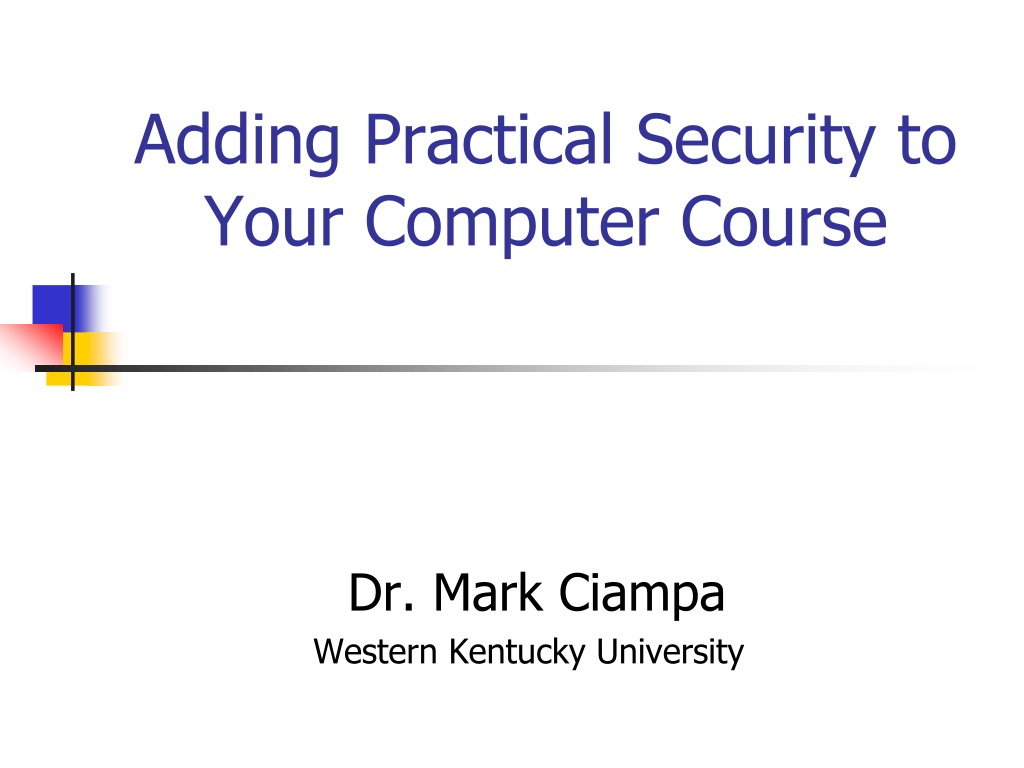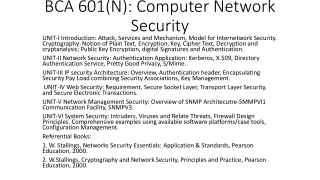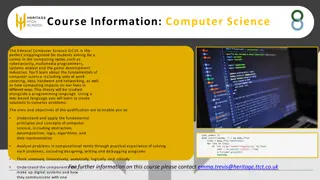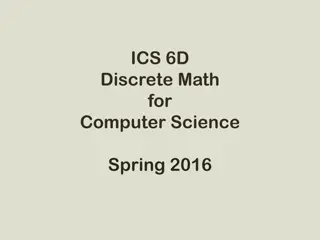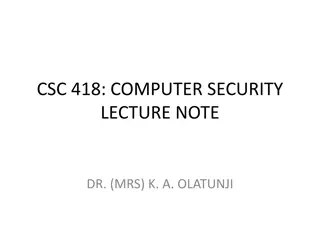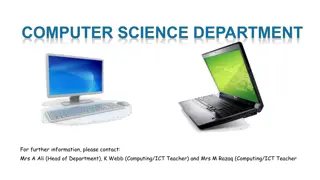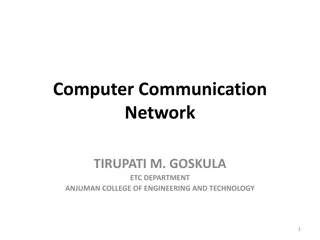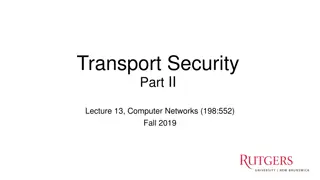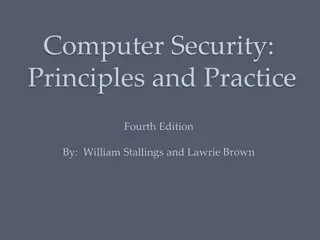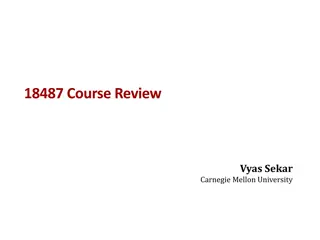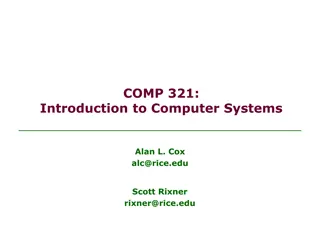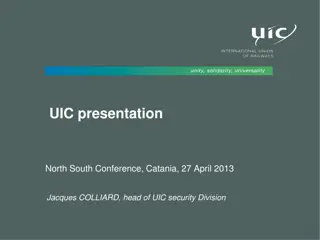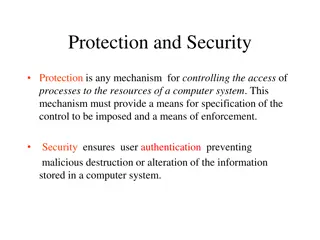Practical Computer Security Course Overview
Explore the crucial aspects of practical computer security in this comprehensive course led by Dr. Mark Ciampa from Western Kentucky University. From analyzing security vulnerabilities to understanding cyber threats and safeguarding your digital assets, this course equips you with essential knowledge to protect your computer effectively. Dive into real-world examples, learn about recent security breaches, and discover practical strategies to enhance your computer's security posture.
Download Presentation

Please find below an Image/Link to download the presentation.
The content on the website is provided AS IS for your information and personal use only. It may not be sold, licensed, or shared on other websites without obtaining consent from the author.If you encounter any issues during the download, it is possible that the publisher has removed the file from their server.
You are allowed to download the files provided on this website for personal or commercial use, subject to the condition that they are used lawfully. All files are the property of their respective owners.
The content on the website is provided AS IS for your information and personal use only. It may not be sold, licensed, or shared on other websites without obtaining consent from the author.
E N D
Presentation Transcript
Adding Practical Security to Your Computer Course Dr. Mark Ciampa Western Kentucky University
150,000,000 A. Number of additional cars that Toyota is recalling for accelerator pedal entrapment B. How many hits on Charles Barkley s I May Be Wrong But I Doubt It video C. Number of computers remotely controlled by attackers 2
214 A. The number of violations found by the NCCA against the University of Tennessee B. How many mouse clicks are needed to navigate the Course Technology Web site C. Number of Apple security patches released in 3 weeks 3
41 A. How many of your students who still send you e-mails with text message spelling B. The number of different predictions of which NFL team Cam Newton will play for C. Percentage of successful infections from USB drives 4
$9.3 Billion A. Average CEO salary in 2011 B. Average college president salary in 2011 C. Amount of money lost in the U.S. to the Nigerian General fraud scheme last year 5
50% A. How much your retirement account lost since 2008 B. Price your new flat panel TV dropped the week after you bought it C. Percentage of Americans who had their credit card or SSN exposed online 6
39 Seconds A. Time it took the person sitting next to you at breakfast this morning to inhale that donut B. How often you keep checking your watch to see when this presentation is finally over C. Frequency a computer is probed on the Internet 7
More Bad News Web pages that infect by simply looking at them (6,000 new infected pages daily, or 1 every 14 seconds) More attacks originate in U.S. than any other country (33%) Home users were the most highly targeted sector (93% all targeted attacks) An infected U.S. computer has an average of 8 instances of malware U.S. has highest number of infected computers 8
Dramatic Changes Attack targets Attack methods 10
10 Years Ago: Fame Individual local hackers Wanted show off abilities Created nuisance worms and viruses 11
Today: Fortune Organized international groups Motive is financial gain Steal confidential information instead of destroy Create customized malware Blend multiple attacks 12
Common Denominator? IE Drive-By Download Stuxnet Worm Binary Planting 13
IE Drive-By Download User receives an e-mail contains link to web site been compromised & tricked into clicking it Link points to a web page that contains script that determines user's browser If the browser is IE6/7 then malware is downloaded that contains remote execution program Malware opens a backdoor on the computer and contacts the attacker's remote server in Poland 14
IE Drive-By Download Site downloads small files with ".gif" extension (which are stored on yet another compromised web server that owner does not know has been compromised) Files are not images but instead are encrypted files with commands telling the malware what to do next to the computer 15
Stuxnet Worm Best malware ever Written in multiple languages (C, C++ and other object-oriented languages) Exploited 4 zero day vulnerabilities Targeted Windows computers that managed large-scale industrial-control systems Internal counter allowed it to spread to maximum of 3 computers 16
Stuxnet Worm Infiltrated by infected USB flash drives Stuxnet gained administrative access to other computers on network and then looked for computers running control systems Exploited default passwords on control systems Reprogramed programmable logic control (PLC) software to give machinery attached to systems new instructions 17
Binary Planting Attacker plants malicious .EXE or .DLL "binary" on a remote location, such as a network share that the attacker controls User tricked into opening a data file (like a document or .MP3) on that remote location so malicious binary launched A user on Windows XP using IE6/7/8 will not be warned if they click on a link that automatically downloads a malicious DLL 18
Binary Planting Because many Windows applications don't call DLLs using a full path name (C:\Windows\Microsoft.NET\Framework\sbs_i ehost.dll) but instead only use filename (sbs_iehost.dll) the application could load the malicious file with the same filename as a required DLL Microsoft said it cannot fix this binary planting problem but that developers of applications must instead fix their own applications. Secunia has identified this vulnerability in over 175 widely-used Windows applications 19
Common Denominator? IE Drive-By Download Stuxnet Worm Binary Planting 20
Common Denominator Attackers combining technology with user ignorance and confusion 21
Why Increase In Attacks Speed of attacks More sophisticated attacks Simplicity of attack tools Faster detection weaknesses Delays in user patching Distributed attacks Exploit user ignorance/confusion 22
Ignorance Definition: Unintelligence, inexperience Synonyms: Benightedness, bewilderment, blindness, callowness, crudeness, darkness, denseness, disregard, dumbness, empty-headedness, fog, half- knowledge, illiteracy, incapacity, incomprehension, innocence,, insensitivity, lack of education, mental incapacity, naivet , nescience, oblivion, obtuseness, philistinism, shallowness, simplicity, unawareness, unconsciousness, uncouthness, unenlightenment, unfamiliarity, unscholarliness, vagueness Antonyms: competence, cultivation, education, experience, intelligence, knowledge, literacy, talent, wisdom 23
User Confusion Confusion over different attacks: Worm or virus? Adware or spyware? Rootkit or Trojan? Confusion over different defenses: Antivirus? Firewall? Patches? Users asked to make security decisions and perform technical procedures 24
User Confusion Will you grant permission to open this port? Is it safe to unquarantine this attachment? May I install this add-in? 25
User Confusion 88% use their home computer for online banking, stock trading, reviewing personal medical information, and storing financial information, health records, and resumes 98% agree important to be able to know risk level of a web site before visiting it (But 64% admit don t know how to) 92% think that their anti-virus software is up to date (But only 51% have current anti-virus software that been updated within last 7 days) 26
User Confusion 44% don t understand firewalls 25% have not even heard of the term phishing , only 13% can accurately define it 22% have anti-spyware software installed, an enabled firewall, and anti- virus protection that has been updated within last 7 days 27
User Misconceptions I don t have anything on my computer they want I have antivirus software so I m protected My IT person takes care of security here at work My Apple computers is safe 28
Calls for Vigilance Securing your home computer helps you and your family, and it also helps your nation . . . by reducing the risk to our financial system from theft, and to our nation from having your computer infected and then used as a tool to attack other computers Janet Napolitano Department Homeland Security 29
Calls for Training National Strategy to Secure Cyberspace (NSSC) document, created by U.S. President s National Infrastructure Advisory Council, calls for comprehensive national security awareness program to empower all Americans, including the general population, to secure their own parts of cyberspace Department of Homeland Security, through the NSSC, calls upon home users to help the nation secure cyberspace by securing their own connections to it 30
Calls for Training Action and Recommendation 3-4 of NSSC calls upon colleges and universities to model user awareness programs and materials Colloquium for Information Systems Security Education (CISSE), International Federation of Information Processing Working Group 11.8 on Information Security Education (IFIP WISE), and Workshop on Education in Computer Security (WECS) all involved in security training in schools Bipartisan Cybersecurity Enhancement Act would fund more cybersecurity research, awareness and education (Feb 20 2011) 31
Calls for Training Researchers state that institutions of higher education (IHEs) should be responsible for providing security awareness instruction, including Crowley (2003), Mangus (2002), Null (2004), Tobin and Ware (2005), Valentine (2005), Werner (2005), and Yang (2001) Security instruction and training important not only to meet current demands of securing systems but also to prepare students for employment in their respective fields Location of security awareness instruction and training in a college curriculum should not be isolated in upper-level courses for IT majors, according to Tobin and Ware (2005), Werner (2005), and others Instruction should be taught to all graduates as a security awareness course (Valentine, 2005) along with integrating it across through the curriculum (Yang, 2001) Long (1999) advocated that security instruction should begin as early as kindergarten 32
Security Education In Schools Teach network security to computer majors Brief coverage of security in Introduction to Computers courses where teach definitions Yet leaving out practical security awareness for all students 33
Security Education Challenge Need educate all students about practical computer security awareness Security Literacy - Why and how to make personal computers secure Users should be as fluent with security literacy as with Office or e-mail
Objections Students don t care about security I m not a security expert to teach it 35
Recent Study Surveyed 679 students a university and community college First day of Introduction to Computers class Students had received no instruction about security in class Students had no previous computer courses at the school Asked if specific security items were important to them 36
Recent Study 37
Anti-virus Software? Response Count Question 1 1 427 2 204 Mean 1.487518 3 34 Standard Error 0.030121 4 5 Median 1 5 7 Mode 1 6 4 Standard Deviation 0.78604 Blank 14 Sample Variance 0.617859 Kurtosis 8.596261 Skewness 2.437466 Range 5 Minimum 1 Maximum 6 Sum 1013 Count 681 Largest(1) 6 Smallest(1) 1 39 Confidence Level(95.0%) 0.059142
Experts Not Needed Attacks are targeting user ignorance and confusion Need teach basic security awareness skills and knowledge Should not teach advanced technology security topics Often security experts get too carried away and need not apply! 44
Security Awareness Topics Introduction to Security Desktop Security Internet Security Personal Security Wireless Network Security Enterprise Security
Adding Practical Security to Your Computer Course Teaching Practical Security Awareness Desktop Security
What Is Information Security? That which protects the integrity, confidentiality, and availability of information on the devices that store, manipulate, and transmit the information through products, people, and procedures Security may be viewed as sacrificing convenience for safety May be inconvenient to lock all the doors of the house or use long and complex passwords, the tradeoff is that these steps result in a higher level of safety. Giving up short-term ease for long-term protection. Security is making sacrifices to achieve a greater good.
Desktop Security Describe the different types of software and hardware attacks List types of desktop defenses Explain how to recover from an attack
Virus Virus Malicious computer code that reproduces itself on the same computer Virus inserts itself into a computer file (which can be either a data file or program) Whenever infected program is launched looks to reproduce itself by inserting its code into another file on the same computer and performs malicious action
Virus Virus can only replicate itself on the host computer on which it is located; it cannot automatically spread to another computer Must typically rely on the actions of users to spread the virus to other computers Because viruses are attached to files, it is spread by a user transferring those files to other devices
